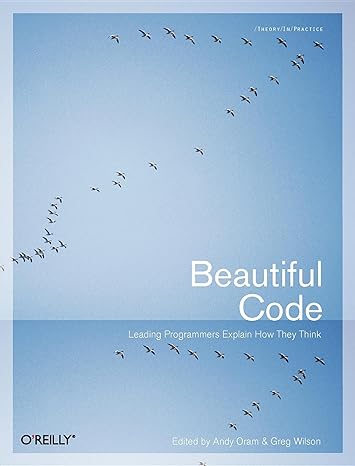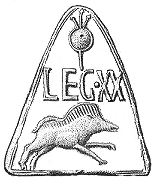
This review is of Beautiful Code edited by Andy Oram and Greg Wilson, a collection of 33 essays by 41 authors about computer code that the authors consider beautiful. A number of the authors are very well known, including Brian Kernighan, Charles Petzold, Douglas Crockford and Yukihiro Matsumoto.
The chapters vary considerably in length but average a little under 20 pages which works well for me – I find 20 pages is a reasonable chunk to read in one go. Although the chapters are presented without any organization, they are actually grouped into themes.
A few chapters are on algorithms, which is what I think of when people talk about beautiful code. A few chapters are on applications, and their architecture, a couple are on assistive technologies, a couple are on libraries/frameworks. A few are on operating system code: device driver architecture and handling threads. It is fair to say that beauty is in the eye of the beholder, and generally I felt authors wrote about their favourite piece of work rather than something that might be broadly considered beautiful code.
Several chapters I was more interested in the subject area than the actual code. There are a couple of chapters on bioinformatics (I was a lecturer in Biological Physics for a couple of years), a couple on Python (my primary programming language for the last 10 years or so) . The Python chapters are on the implementation of the dictionary in the core language and multidimensional iterators in Numpy (a widely used numerical library). The NASA chapter was a bit of a let-down since it involved strictly ground based code. However, I was excited to learn about the challenges of two Martian time zones as well as earth based time zones!
Pretty much all of the chapters contain moderate amounts of code. The implementing language varies, there are a number written using examples in Lisp. Ruby and Perl have a couple of outings, as does Haskell, also present are Java, C#, Python and C. Reading through the author biographies it seems some of them were involved in the creation or ongoing development of some of these languages.
I gave up on one chapter in part because it was in Lisp (not a language I’ve ever used) with no support except a suggestion to go read the first few chapters of the author’s book on Scheme (a dialect of Lisp) but also because it was about macro expansion which I’ve always considered a nasty kludge. Brian Hayes’ chapter also used Lisp but provides a little schematic diagram showing the structure of a Lisp function which was really helpful. Lisp programmers really like their brackets!
It was interesting to learn about Lisp’s advice functionality which is like Python decorators. Haskell is neat in its very clean separation between pure functions and functions with side effects. I can’t help thinking that both languages are best suited to highly mathematical developers working alone, their notation is exceedingly concise and impenetrable to outsiders. However, ideas from these more esoteric languages are usefully incorporated to more mainstream ones and programming styles.
Binary search and sorting are a feature of several of the early chapters. One author points out it took 12 years after its invention for a correct implementation of binary search to be written, and only 10% of developers get it right first time when implementing it themselves. The core error is an issue with numeric overflow which highlights that the difficulty of coding comes not just from algorithmic design but also lower level implementation details. The later chapter on the numerical analysis libraries from CERN (BLAS, LINPACK, LAPACK) highlight this again, optimum algorithms changed as the underlying machine CPU, memory and network architectures changed. The book finishes with a chapter on algorithms for checking the collinearity of three points on a plane, I liked this one. The twist at the end is that the best algorithm is to measure the area of the triangle the three points form, if it is zero then the points are colinear. This algorithm has the benefit if numerical stability, again a imposition of underlying numerical representation.
I liked the chapter on a logging framework, it made frequent references to design patterns and seemed like a nice example of beauty in higher level design.
In my view Charles Petzold’s chapter describes eldritch code, rather than beautiful! He shows how to generate C# intermediate language (IL) at runtime in order to speed up image processing operations. This involves line by line generation of raw IL using C#’s reflection functions. I’m not saying it is not very cunning or interesting but it isn’t pretty. It is also a personal interest of mine since I spent a number of years working on image analysis.
Some of the applications discussed have stood the test of time, ERP5 is still around as is Emacspeak (accessibility software for the blind). I can find no trace of Cryptonite (an email client) or Elocutor (accessibility software originally designed for Professor Stephen Hawking). Components of the Subversion and Perforce source control applications are included. Obsolesce seems to be a combination of the language used, the change in the web and competition. Beautiful Code was written in 2007, nearly 20 years ago and the web was a very different place then.
A couple of chapters talked about how code appeared on the page – I particularly liked the idea of “bookish” code, code laid out in the manner of a book or magazine to aid readability – interestingly this chapter was in favour of shorter variable names for readability rather than longer ones for description. A recurring theme is that the code is never beautiful in the first instance, it normally reaches beauty by a process of iteration and refinement.
The book was first published in 2007, and its age shows in some places. It finishes with biographies of the authors which could have more usefully been put with their respective chapters. I was sad to see that only one author appears to be a woman, I suspect this would be the case if the book was written now.
I enjoyed this book, most of the chapters struck some sort of cord with me.
